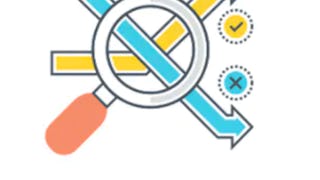This is part of our specialization on Making Decision in Time. For this second course we start with a landmark paper from Chernoff and build new insights into the ideas that his paper sparked. The ending point should bring new code and new algorithm insights into perspective, and use, by many computer and data scientists.



Data Science Decisions in Time:Sequential Hypothesis Testing
Ce cours fait partie de Spécialisation Data Science Decisions in Time

Instructeur : Thomas Woolf
Inclus avec 
Expérience recommandée
Expérience recommandée
Détails à connaître

Ajouter à votre profil LinkedIn
11 devoirs
Découvrez comment les employés des entreprises prestigieuses maîtrisent des compétences recherchées

Élaborez votre expertise du sujet
- Apprenez de nouveaux concepts auprès d'experts du secteur
- Acquérez une compréhension de base d'un sujet ou d'un outil
- Développez des compétences professionnelles avec des projets pratiques
- Obtenez un certificat professionnel partageable


Obtenez un certificat professionnel
Ajoutez cette qualification à votre profil LinkedIn ou à votre CV
Partagez-le sur les réseaux sociaux et dans votre évaluation de performance

Il y a 6 modules dans ce cours
We extend Wald's ideas for sequential hypothesis testing to a new -- and closely related -- problem. In this second course we evaluate how best to choose from a set of hypothesis for sequentially arriving data. This has many modern applications, for example how best to set a price for a new product, what is the best therapy for a patient, how to determine the rare events in a stream of visual images and many many more. We begin by examining a type of visual search for the 'odd one out' and then build from that first week.
Inclus
3 vidéos1 lecture2 devoirs
Searching within an ordered hierarchical setting can improve the search. But, it is not immediately obvious how to setup the data structure to support this type of search. In this part of the course we explore how to define a biased walk, based on information, to quickly find an 'odd one out'. From this concept of walking along a tree structure, we then move into thinking about how to best setup that tree structure.
Inclus
3 vidéos1 lecture2 devoirs
Many real-world applications have extremely large action and/or hypothesis spaces. For the application of Chernoff's ideas there has to be a way to apply the algorithms quickly at scale. In this set of material we examine how approximations may work and how Chernoff's ideas have been extended to different types of problems.
Inclus
3 vidéos1 lecture2 devoirs
The ideas that we have been exploring can also be applied to data slices collected at disparate windows in time, can be applied to improving MRI scans and can be applied to molecular protein design. These applications all share the concept of using sequential hypothesis testing to improve understanding. In addition, all three of these ideas are under active code development.
Inclus
3 vidéos1 lecture2 devoirs
In our fifth week we explore how to move beyond the 'odd one out' and into multiple hypothesis testing for streams of data. This could be for setting a dosage level on a medication or on how to identify objects in a set of images.
Inclus
5 vidéos1 lecture2 devoirs
Inclus
1 devoir
Instructeur

Offert par
Recommandé si vous êtes intéressé(e) par Software Development


Johns Hopkins University


Johns Hopkins University


Johns Hopkins University


Johns Hopkins University
Pour quelles raisons les étudiants sur Coursera nous choisissent-ils pour leur carrière ?





Ouvrez de nouvelles portes avec Coursera Plus
Accès illimité à 10,000+ cours de niveau international, projets pratiques et programmes de certification prêts à l'emploi - tous inclus dans votre abonnement.
Faites progresser votre carrière avec un diplôme en ligne
Obtenez un diplôme auprès d’universités de renommée mondiale - 100 % en ligne
Rejoignez plus de 3 400 entreprises mondiales qui ont choisi Coursera pour les affaires
Améliorez les compétences de vos employés pour exceller dans l’économie numérique
Foire Aux Questions
Access to lectures and assignments depends on your type of enrollment. If you take a course in audit mode, you will be able to see most course materials for free. To access graded assignments and to earn a Certificate, you will need to purchase the Certificate experience, during or after your audit. If you don't see the audit option:
The course may not offer an audit option. You can try a Free Trial instead, or apply for Financial Aid.
The course may offer 'Full Course, No Certificate' instead. This option lets you see all course materials, submit required assessments, and get a final grade. This also means that you will not be able to purchase a Certificate experience.
When you enroll in the course, you get access to all of the courses in the Specialization, and you earn a certificate when you complete the work. Your electronic Certificate will be added to your Accomplishments page - from there, you can print your Certificate or add it to your LinkedIn profile. If you only want to read and view the course content, you can audit the course for free.
If you subscribed, you get a 7-day free trial during which you can cancel at no penalty. After that, we don’t give refunds, but you can cancel your subscription at any time. See our full refund policy.

